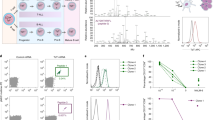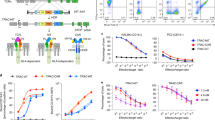Abstract
Lymphoblastoid cell lines (LCLs), which are established by in vitro infection of peripheral B-lymphocytes with Epstein–Barr virus (EBV), are effective antigen-presenting cells. However, the ability of LCLs to present transduced tumor antigens has not yet been evaluated in detail. We report a single-step strategy utilizing a recombinant EBV (maxi-EBV) to convert B-lymphocytes from any individuals into indefinitely growing LCLs expressing a transgene of interest. The strategy was successfully used to establish LCLs expressing Wilms’ tumor gene 1 (WT1) tumor antigen (WT1-LCLs), which is an attractive target for cancer immunotherapy. The established WT1-LCLs expressed more abundant WT1 protein than K562 leukemic cells, which are known to overexpress WT1. A WT1-specific cytotoxic T lymphocyte line efficiently lysed the WT1-LCL in a human leukocyte antigen-restricted manner, but poorly lysed control LCL not expressing WT1. These results indicate that the transduced WT1 antigen is processed and presented on the WT1-LCL. This experimental strategy can be applied to establish LCLs expressing other tumor antigens and will find a broad range of applications in the field of cancer immunotherapy.
This is a preview of subscription content, access via your institution
Access options
Subscribe to this journal
Receive 12 print issues and online access
$259.00 per year
only $21.58 per issue
Buy this article
- Purchase on Springer Link
- Instant access to full article PDF
Prices may be subject to local taxes which are calculated during checkout




Similar content being viewed by others
References
Kieff E, Rikinson AB . Epstein-Barr virus and its replication. In: Knipe M, Howley PM, (eds). Fields Virology, Vol 2. 4th edn. Lippincott Williams and Wilkins: Philadelphia, 2001, pp 2511–2573.
Miller G, Lipman M . Release of infectious Epstein-Barr virus by transformed marmoset leukocytes. Proc Natl Acad Sci USA 1973; 70: 190–194.
Kuzushima K, Hayashi N, Kudoh A, Akatsuka Y, Tsujimura K, Morishima Y et al. Tetramer-assisted identification and characterization of epitopes recognized by HLA A*2402-restricted Epstein-Barr virus-specific CD8+ T cells. Blood 2003; 101: 1460–1468.
Rickinson AB, Moss DJ . Human cytotoxic T lymphocyte responses to Epstein-Barr virus infection. Annu Rev Immunol 1997; 15: 405–431.
Young LS, Rickinson AB . Epstein-Barr virus: 40 years on. Nat Rev Cancer 2004; 4: 757–768.
Rickinson AB, Moss DJ, Allen DJ, Wallace LE, Rowe M, Epstein MA . Reactivation of Epstein-Barr virus-specific cytotoxic T cells by in vitro stimulation with the autologous lymphoblastoid cell line. Int J Cancer 1981; 27: 593–601.
Rooney CM, Smith CA, Ng CY, Loftin S, Li C, Krance RA et al. Use of gene-modified virus-specific T lymphocytes to control Epstein-Barr-virus-related lymphoproliferation. Lancet 1995; 345: 9–13.
Moss DJ, Rickinson AB, Pope JH . Long-term T-cell-mediated immunity to Epstein-Barr virus in man. I. Complete regression of virus-induced transformation in cultures of seropositive donor leukocytes. Int J Cancer 1978; 22: 662–668.
Rickinson AB, Kieff E . Epstein-Barr virus. In: Knipe M, Howley PM, (eds). Fields Virology, Vol 2. 4th edn. Lippincott Williams and Wilkins: Philadelphia, 2001, pp 2575–2627.
Doubrovina ES, Doubrovin MM, Lee S, Shieh J-H, Heller G, Pamer E et al. In vitro stimulation with WT1 peptide-loaded Epstein-Barr virus-positive B cells elicits high frequencies of WT1 peptide-specific T cells with in vitro and in vivo tumoricidal activity. Clin Cancer Res 2004; 10: 7207–7219.
Sun Q, Pollok KE, Burton RL, Dai LJ, Britt W, Emanuel DJ et al. Simultaneous ex vivo expansion of cytomegalovirus and Epstein-Barr virus-specific cytotoxic T lymphocytes using B-lymphoblastoid cell lines expressing cytomegalovirus pp65. Blood 1999; 94: 3242–3250.
Leen AM, Myers GD, Sili U, Huls MH, Weiss H, Leung KS et al. Monoculture-derived T lymphocytes specific for multiple viruses expand and produce clinically relevant effects in immunocompromised individuals. Nat Med 2006; 12: 1160–1166.
Moosmann A, Khan N, Cobbold M, Zentz C, Delecluse HJ, Hollweck G et al. B cells immortalized by a mini-Epstein-Barr virus encoding a foreign antigen efficiently reactivate specific cytotoxic T cells. Blood 2002; 100: 1755–1764.
Kempkes B, Pich D, Zeidler R, Hammerschmidt W . Immortalization of human primary B lymphocytes in vitro with DNA. Proc Natl Acad Sci USA 1995; 92: 5875–5879.
Kempkes B, Pich D, Zeidler R, Sugden B, Hammerschmidt W . Immortalization of human B lymphocytes by a plasmid containing 71 kilobase pairs of Epstein-Barr virus DNA. J Virol 1995; 69: 231–238.
Delecluse HJ, Hilsendegen T, Pich D, Zeidler R, Hammerschmidt W . Propagation and recovery of intact, infectious Epstein-Barr virus from prokaryotic to human cells. Proc Natl Acad Sci USA 1998; 95: 8245–8250.
Kilger E, Pecher G, Schwenk A, Hammerschmidt W . Expression of mucin (MUC-1) from a mini-Epstein-Barr virus in immortalized B-cells to generate tumor antigen specific cytotoxic T cells. J Gene Med 1999; 1: 84–92.
Call KM, Glaser T, Ito CY, Buckler AJ, Pelletier J, Haber DA et al. Isolation and characterization of a zinc finger polypeptide gene at the human chromosome 11 Wilms’ tumor locus. Cell 1990; 60: 509–520.
Lee SB, Haber DA . Wilms tumor and the WT1 gene. Exp Cell Res 2001; 264: 74–99.
Miwa H, Beran M, Saunders GF . Expression of the Wilms’ tumor gene (WT1) in human leukemias. Leukemia 1992; 6: 405–409.
Oka Y, Tsuboi A, Taguchi T, Osaki T, Kyo T, Nakajima H et al. Induction of WT1 (Wilms’ tumor gene)-specific cytotoxic T lymphocytes by WT1 peptide vaccine and the resultant cancer regression. Proc Natl Acad Sci USA 2004; 101: 13885–13890.
Kanda T, Yajima M, Ahsan N, Tanaka M, Takada K . Production of high-titer Epstein-Barr virus recombinants derived from Akata cells by using a bacterial artificial chromosome system. J Virol 2004; 78: 7004–7015.
Kanda T, Shibata S, Saito S, Murata T, Isomura H, Yoshiyama H et al. Unexpected instability of family of repeats (FR), the critical cis-acting sequence required for EBV latent infection, in EBV-BAC systems. PLoS One 2011; 6: e27758.
Graham FL, Smiley J, Russell WC, Nairn R . Characteristics of a human cell line transformed by DNA from human adenovirus type 5. J Gen Virol 1977; 36: 59–74.
Haber DA, Sohn RL, Buckler AJ, Pelletier J, Call KM, Housman DE . Alternative splicing and genomic structure of the Wilms tumor gene WT1. Proc Natl Acad Sci USA 1991; 88: 9618–9622.
Zhang Y, Muyrers JP, Testa G, Stewart AF . DNA cloning by homologous recombination in Escherichia coli. Nat Biotechnol 2000; 18: 1314–1317.
Yasukawa M, Inatsuki A, Horiuchi T, Kobayashi Y . Functional heterogeneity among herpes simplex virus-specific human CD4+ T cells. J Immunol 1991; 146: 1341–1347.
Okamoto S, Mineno J, Ikeda H, Fujiwara H, Yasukawa M, Shiku H et al. Improved expression and reactivity of transduced tumor-specific TCRs in human lymphocytes by specific silencing of endogenous TCR. Cancer Res 2009; 69: 9003–9011.
Niwa H, Yamamura K, Miyazaki J . Efficient selection for high-expression transfectants with a novel eukaryotic vector. Gene 1991; 108: 193–199.
Argast GM, Stephens KM, Emond MJ, Monnat Jr RJ . I-PpoI and I-CreI homing site sequence degeneracy determined by random mutagenesis and sequential in vitro enrichment. J Mol Biol 1998; 280: 345–353.
Shaner NC, Campbell RE, Steinbach PA, Giepmans BN, Palmer AE, Tsien RY . Improved monomeric red, orange and yellow fluorescent proteins derived from Discosoma sp. red fluorescent protein. Nat Biotechnol 2004; 22: 1567–1572.
Ohminami H, Yasukawa M, Fujita S . HLA class I-restricted lysis of leukemia cells by a CD8(+) cytotoxic T-lymphocyte clone specific for WT1 peptide. Blood 2000; 95: 286–293.
Feederle R, Kost M, Baumann M, Janz A, Drouet E, Hammerschmidt W et al. The Epstein-Barr virus lytic program is controlled by the co-operative functions of two transactivators. EMBO J 2000; 19: 3080–3089.
Wade-Martins R . Developing extrachromosomal gene expression vector technologies: an overview. Methods Mol Biol 2011; 738: 1–17.
Kast WM, Levitsky H, Marincola FM . Synopsis of the 6th Walker’s Cay colloquium on cancer vaccines and immunotherapy. J Transl Med 2004; 2: 20.
Osada T, Woo CY, McKinney M, Yang XY, Lei G, Labreche HG et al. Induction of Wilms’ tumor protein (WT1)-specific antitumor immunity using a truncated WT1-expressing adenovirus vaccine. Clin Cancer Res 2009; 15: 2789–2796.
Acknowledgements
We thank K Semba (Waseda University) for providing us with WT1 complementary DNA plasmids. This work was supported in part by a Grant-in-Aid for Scientific Research from the Ministry of Education, Culture, Sports, Science, and Technology, Japan (TK and TT), by a Grant-in-Aid for Scientific Research the Ministry of Health Labour and Welfare (TK and KK), by a grant of NOASTEC (Northern Advancement Center for Science and Technology) (TK), and by a grant from the Naito Foundation (TK).
Author information
Authors and Affiliations
Corresponding author
Ethics declarations
Competing interests
The authors declare no conflict of interest.
Rights and permissions
About this article
Cite this article
Kanda, T., Ochi, T., Fujiwara, H. et al. HLA-restricted presentation of WT1 tumor antigen in B-lymphoblastoid cell lines established using a maxi-EBV system. Cancer Gene Ther 19, 566–571 (2012). https://doi.org/10.1038/cgt.2012.34
Received:
Revised:
Accepted:
Published:
Issue Date:
DOI: https://doi.org/10.1038/cgt.2012.34
Keywords
This article is cited by
-
Human γδ T cells induce CD8+ T cell antitumor responses via antigen-presenting effect through HSP90-MyD88-mediated activation of JNK
Cancer Immunology, Immunotherapy (2023)



